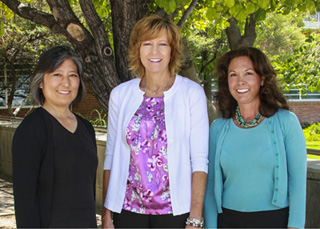
Cynthia Nitta, left, from Lawrence Livermore National Laboratory, Wendy Baca, center, Los Alamos National Laboratory, and Sheryl Hingorani, from Sandia, lead a team that is developing plans and options for future strategy. (Photo by Stephanie Blackwell)
Note: This article first appeared on DOE’s Office of Economic Impact and Diversity blog (energy.gov/diversity), as part of DOE’s Women in STEM initiative.
DOE’s 17 national laboratories employ brilliant minds, addressing the greatest science and technology issues facing our planet — from climate change and energy solutions to space exploration to national security.
Amid these are three nuclear weapons laboratories that share the critical responsibilities of ensuring the safety, security, and effectiveness of the US nuclear deterrent.
Collaboration between these labs, and throughout the National Nuclear Security Administration’s nuclear security enterprise, is crucial to delivering on this multifaceted mission.
One “tri-lab” team cutting across lab boundaries is led by three female engineers — from Lawrence Livermore, Los Alamos, and Sandia national laboratories. Together, Wendy Baca (Los Alamos), Sheryl Hingorani (Sandia), and Cynthia Nitta (Lawrence Livermore) lead a newly formed team that is developing plans and options for future strategy.
Toward a cohesive vision
“Our collective perspective looks far beyond what we’re doing today,” says Sheryl. “We anticipate and plan for what we may need 10, 20 years down the road, even into the middle of the century.”
The team works toward a cohesive vision for the future of the US nuclear deterrent from a laboratories’ point of view. As Federally Funded Research and Development Centers, the labs are trusted government partners structured to meet special long-term research and development needs, to operate autonomously in the public interest, and to attract personnel with the highest level of expertise.
“At a national lab we’re able to tackle huge global problems — intricate, long-term, multidisciplinary problems that no one else can,” says Nitta. “I work around world-class minds, people who’ve had a significant impact on history . . . and they’re humble and ready to help wherever it’s needed.”
“It’s like working for Elvis,” Baca adds.
“We’re standing on the shoulders of giants here,” Sheryl agrees. “And that sense of duty is powerful.”
The team meets regularly to anticipate needs for 21st century nuclear deterrence and to help inform priorities so that the most essential activities are accomplished within the labs’ available budgets. They collaborate on approaches with the entire US nuclear weapons community and advocate for collective action in the best interests of the nation.
“This team has been very valuable,” says Sheryl.
“It helps us better understand and explore interdependencies across the laboratories. None of us works in a vacuum.”
With nearly 30 years apiece in national security roles, each of these women has dedicated her career to serving the nation in an incredibly unique niche. As leaders in the predominantly male industries of engineering and nuclear weapons, the group welcomes the challenge.
Actions speak louder than gender
“There were so few women when I started,” Nitta recalls. “That has changed over time. I’ve tried to learn continuously, and to be known as someone who gets things done.”
The women explain that throughout their careers their actions have spoken louder than gender — that if you deliver quality projects, people will want to work with you based on your merits.
Executive leadership from each lab initiated the directive for the tri-lab team, with mutual recognition for the power of a shared collective on crucial issues. The women agree that edict has been critical to the team’s success.
“The team’s formation wasn’t about being women; it was about the skills and knowledge we have, the experience we brought to the role,” says Baca. “We knew the three of us could make it work.”
“We approached this with a perspective of collaboration, rather than competition,” says Nitta.
They draw expertise in from a variety of areas across the laboratories, uniting disciplines that may otherwise rarely interact. In addition to broad expertise, diversity adds value to the team, but not necessarily gender diversity.
“It’s a diversity of ideas,” Nitta stresses. “It’s important to have someone in the room with a different view than yours; that’s some of the most valuable input I ever receive.”
What advice would Sheryl, Baca, and Nitta share with women pursuing STEM careers?
“Don’t get so myopic in finishing your degree that you miss opportunities along the way,” says Baca. “No matter what it may feel like at the time, keep learning. I had three different majors before I became an industrial engineer.”
“I had four,” says Nitta.
Sheryl changed her major six times: “Although it took me longer, I was exposed to a breadth of experiences, and was able to enjoy the journey.”
As they meet deadlines and milestones, the group agrees they are chiefly focused on building strong relationships and making sure the team is solid — on enjoying the journey, not just the destination.